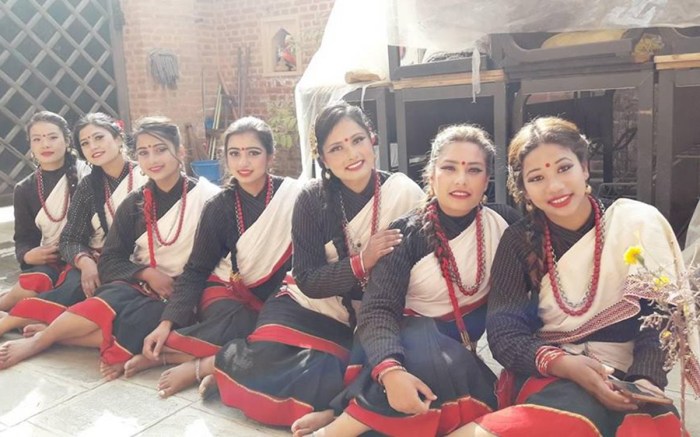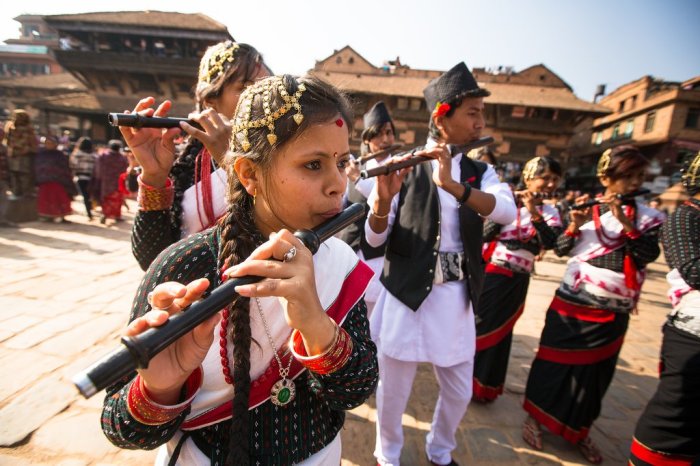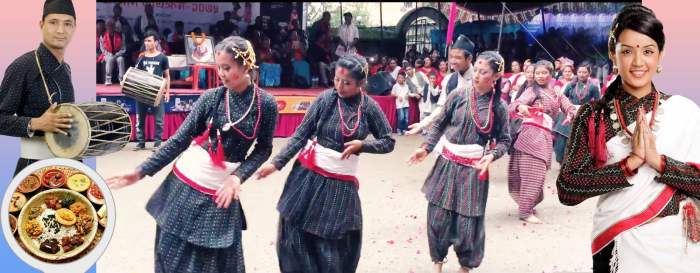Immerse yourself in the vibrant tapestry of Newari culture and tradition, a rich heritage that has flourished for centuries in the Kathmandu Valley of Nepal. Steeped in a harmonious blend of Hinduism and Buddhism, Newari society showcases a captivating array of religious practices, architectural marvels, and artistic expressions that continue to captivate the hearts of visitors and locals alike.
From the vibrant festivals that paint the streets with color and music to the intricate craftsmanship that adorns temples and homes, Newari culture is a testament to the enduring spirit of a people deeply rooted in their ancestral traditions. Let us embark on a journey to explore the fascinating world of Newari culture, unraveling its historical significance, vibrant expressions, and enduring legacy.
Introduction
Newari culture and tradition refer to the unique and vibrant customs, beliefs, and practices of the Newari people, an indigenous ethnic group primarily residing in the Kathmandu Valley of Nepal. Their culture is renowned for its rich heritage, artistic traditions, and religious festivals.
The significance of Newari culture lies in its ability to preserve and transmit the history, identity, and values of the Newari community. It has been passed down through generations, shaping the social, economic, and religious aspects of Newari life. The history of Newari culture dates back centuries, with influences from various sources, including Buddhism, Hinduism, and Tibetan culture.
Religious Practices
Newari religious practices are a captivating blend of Hinduism and Buddhism, each contributing deities, beliefs, and practices. This unique fusion has shaped the spiritual landscape of the Newari people for centuries.
Hinduism and Buddhism in Newari Culture
Hinduism and Buddhism have intertwined in Newari culture, creating a rich tapestry of beliefs. Key Hindu deities like Shiva, Vishnu, and Devi are revered, while Buddhist teachings on compassion and non-violence are deeply ingrained. This harmonious coexistence manifests in rituals and festivals that seamlessly blend both traditions.
Traditional Festivals and Rituals
Newari festivals and rituals are vibrant expressions of their religious beliefs.
- Bisket Jatra: Celebrates the New Year with a towering pole erected in Kathmandu Durbar Square, symbolizing the renewal of life.
- Gai Jatra: Honors deceased family members, featuring a procession of cows and a belief that they guide the spirits of the departed.
- Indra Jatra: Worships the god Indra, bringing blessings of rain and prosperity, with masked dancers and a grand chariot procession.
Unique Blend of Hindu and Buddhist Influences
The unique blend of Hindu and Buddhist influences in Newari religious practices is evident in:
- Deities and Beliefs: Hindu deities are worshipped alongside Buddhist bodhisattvas, representing the harmonious coexistence of both traditions.
- Rituals and Practices: Festivals and rituals incorporate elements from both religions, such as animal sacrifices (Hindu) and meditation (Buddhist).
- Architecture and Art: Temples and stupas showcase architectural styles influenced by both Hindu and Buddhist traditions, creating a unique aesthetic.
Architecture
Newari architecture is distinctive and has been influenced by both Hindu and Buddhist traditions. The buildings are typically made of red brick and feature intricate wood carvings. The roofs are often sloping and tiled, and the windows are often small and narrow.The
use of materials and design elements in Newari architecture is significant. Red brick is used because it is a durable and fire-resistant material. The wood carvings are often used to depict religious scenes or figures, and the sloping roofs are designed to protect the buildings from the elements.
Building Types
There are many different types of Newari buildings, including temples, monasteries, palaces, and houses. Temples are typically the most elaborate of these buildings, and they often feature multiple roofs and intricate carvings. Monasteries are also often large and elaborate, and they typically house a community of monks or nuns.
Palaces are typically the homes of wealthy families, and they often feature large courtyards and gardens. Houses are typically smaller and more modest than temples, monasteries, and palaces, but they often feature the same basic design elements.
Art and Crafts
Newari art forms encompass a vibrant tapestry of painting, sculpture, and metalwork, each imbued with intricate techniques and profound cultural significance.
Painting
Newari painting is renowned for its intricate mandalas, miniature paintings, and wall frescoes. Thangkas, or religious scroll paintings, depict Buddhist deities and scenes, rendered with vibrant colors and meticulous detail. Notable artists include Chitrakar, Siddhimuni Shakya, and Keshar Singh.
Sculpture
Newari sculpture showcases a blend of Buddhist and Hindu influences. Stone and wood carvings adorn temples, stupas, and monasteries, depicting divine figures, mythical creatures, and scenes from mythology. Famous sculptors include Arniko and his apprentice, Balabahu.
Metalwork
Newari metalworkers create exquisite ornaments, utensils, and religious objects using copper, silver, and gold. They employ traditional techniques like repoussé, chasing, and gilding to embellish their creations. Renowned artisans include Laxmi Prasad Sthapit and Rajendra Shakya.
– Describe the traditional music and dance forms of Newari culture.
Newari music and dance are vibrant and diverse, showcasing the rich cultural heritage of the Newari people. These traditional art forms hold significant religious, cultural, and social significance.
Music
Newari music is characterized by its unique melodies, rhythms, and instrumentation. The sitar, a stringed instrument, is commonly used to create enchanting melodies, while the tabla, a pair of drums, provides a rhythmic foundation. The harmonium, a keyboard instrument, adds melodic depth and harmonic richness.Newari
music plays an integral role in religious ceremonies and festivals. During festivals like Dashain and Tihar, musicians perform traditional songs and melodies that evoke the festive spirit. Music is also an essential element of weddings, funerals, and other important life events.
Dance
Newari dances are as diverse as their music, each with its own symbolic meaning and cultural significance. The lakhe dance, performed during the Indra Jatra festival, features a masked dancer representing the deity Bhairav. The mahakali dance, performed during Dashain, is a symbolic representation of the goddess Durga’s victory over evil.Newari
dances are not only performed during religious ceremonies but also at social gatherings and celebrations. The bhau dance, a graceful and rhythmic dance performed by young women, is a popular form of entertainment at weddings and other festive occasions.The traditional music and dance forms of Newari culture are a testament to the rich artistic heritage of the Newari people.
These art forms continue to thrive, preserving and celebrating the unique identity and traditions of this vibrant community.
Language and Literature

The Newari language, spoken by the Newari people of Nepal, is a Tibeto-Burman language with a rich literary tradition dating back to the 11th century. The language has its own unique script, the Newari script, and is closely related to other Tibeto-Burman languages such as Tibetan and Burmese.
Phonology, Morphology, and Syntax
Newari has a complex phonological system with a large number of consonants and vowels. The language also has a complex system of tones, which can change the meaning of words. The morphology of Newari is agglutinative, meaning that words are formed by adding suffixes to roots.
The syntax of Newari is similar to that of other Tibeto-Burman languages, with the subject of a sentence typically coming before the verb.
History and Evolution
The Newari language has evolved over time, with the earliest known texts dating back to the 11th century. The language has been influenced by a number of other languages, including Sanskrit, Pali, and Nepali. The Newari language is still spoken by a large number of people in Nepal, and it continues to be used in literature, religion, and everyday life.
Genres of Newari Literature
Newari literature is rich and diverse, with a wide range of genres including poetry, drama, and prose. Newari poetry is often characterized by its use of metaphor, simile, and symbolism. Newari drama is often based on religious themes, and Newari prose includes a variety of genres such as fiction, non-fiction, and travel writing.
Themes and Styles
The major themes in Newari literature include love, loss, and the search for meaning in life. Newari literature is often characterized by its use of humor and satire. The language is also rich in imagery, and Newari writers often use vivid descriptions to create a sense of place and atmosphere.
Influence of Other Cultures and Languages
Newari literature has been influenced by a number of other cultures and languages, including Sanskrit, Pali, and Nepali. Sanskrit has had a particularly strong influence on Newari literature, and many Newari writers have used Sanskrit words and phrases in their work.
Pali, the language of the Theravada Buddhist scriptures, has also had a significant influence on Newari literature, particularly in the area of religious writing.
– Cuisine

Newari cuisine is a vibrant and flavorful reflection of the rich cultural heritage of the Newari people. It is characterized by a unique blend of spices, traditional cooking methods, and an emphasis on fresh, local ingredients.Newari cuisine showcases the culinary artistry of the Newari community, with dishes that are not only delicious but also hold cultural and religious significance.
Spices such as cumin, coriander, turmeric, and fenugreek form the backbone of Newari cooking, imparting a distinct aroma and flavor to dishes. Traditional cooking methods, such as the use of clay ovens and copper utensils, further enhance the flavors and textures of Newari cuisine.
– Popular Dishes
Some of the most popular Newari dishes include:
- Momo: Steamed or fried dumplings filled with minced meat or vegetables, served with a spicy tomato-based sauce.
- Chhoela: Grilled buffalo meat marinated in spices and herbs, a delicacy often served during festivals.
- Yomari: A sweet rice dumpling shaped like a fish, filled with molasses and sesame seeds, traditionally eaten during the Yomari Punhi festival.
- Kwati: A spicy soup made with nine types of beans and vegetables, traditionally consumed during the Tihar festival.
- Samay Baji: A traditional breakfast dish consisting of beaten rice, yogurt, and various side dishes.
These dishes are not just culinary delights but also hold cultural and religious significance, often prepared during festivals and ceremonies to honor deities and bring good fortune.
– Local Ingredients
The use of local ingredients is a hallmark of Newari cuisine. Fresh vegetables, such as tomatoes, onions, garlic, and ginger, form the base of many dishes. Herbs like coriander, mint, and basil add freshness and flavor. Locally produced spices, such as cumin, coriander, and turmeric, provide the characteristic aroma and taste.The
incorporation of local ingredients not only enhances the flavors of Newari cuisine but also supports the local economy and promotes sustainable practices. By using what is grown in their own region, Newari cooks create dishes that are not only delicious but also deeply rooted in the culture and environment.
Clothing and Adornment
Newari people take pride in their distinctive attire, which reflects their rich cultural heritage. Traditional clothing holds significant value and is worn during special occasions and festivals.
Women’s traditional attire consists of a long, flowing gunyu (skirt) made of cotton or silk. The gunyu is often adorned with intricate embroidery and colorful patterns. It is paired with a fitted cholo (bodice) that covers the upper body.
Women also wear a patuka (shawl) over their shoulders, which adds elegance and warmth.
Men’s traditional attire is more understated. They wear a loose-fitting daura (pants) made of cotton or wool, along with a suruwal (shirt) that reaches below the knees. A bhadgaunle topi (cap) is a common accessory, which is made of black velvet and features a small brim.
The colors, patterns, and materials used in Newari clothing hold cultural and religious significance. Red is considered auspicious and is often used in bridal attire. Gold and silver embellishments represent wealth and prosperity. Floral motifs and geometric designs are common patterns, symbolizing nature and the cosmos.
Social Customs
Newari society is characterized by a rich and vibrant social fabric. The family unit is the cornerstone of society, with extended families living together under one roof. Marriage is a sacred union, and there are specific customs and traditions associated with it.
Community organizations play a vital role in maintaining social cohesion and providing support to members.
The Newari people have a strong sense of community, and they often participate in social events and gatherings. These events are a way to connect with others, share culture, and celebrate life. The Newari people are also known for their hospitality, and they are always willing to welcome guests into their homes.
Family Structures
Newari families are typically extended families, with multiple generations living together under one roof. The family unit is the most important social structure in Newari society, and it provides a strong sense of support and belonging for its members.
| Clan | Family Structure |
|---|---|
| Bajracharya | Patrilineal, extended family |
| Shakya | Patrilineal, extended family |
| Jyapu | Matrilineal, extended family |
| Tamrakar | Patrilineal, extended family |
Marriage Customs
Marriage is a sacred union in Newari society, and there are specific customs and traditions associated with it. The marriage process typically begins with an engagement ceremony, where the families of the bride and groom exchange gifts and agree on the terms of the marriage.
“I am so excited to be getting married,” said Sita to her friend Laxmi. “I can’t wait to start a new life with my husband.””I know how you feel,” replied Laxmi. “Marriage is a beautiful thing. It’s a union of two souls, and it’s a sacred bond that lasts a lifetime.”
The wedding ceremony is a colorful and elaborate affair, with music, dancing, and feasting. The bride and groom exchange vows and rings, and they are blessed by a priest. After the wedding, the couple moves in with the groom’s family.
Community Organizations
Community organizations play a vital role in Newari society. These organizations provide support to members, and they help to maintain social cohesion. There are many different types of community organizations, including religious organizations, social welfare organizations, and youth organizations.
One of the most important community organizations in Newari society is the guthi. A guthi is a religious organization that is responsible for the upkeep of a temple or shrine. Guthis also provide financial support to members, and they organize social events and gatherings.
Education
The traditional educational system in Newari culture was largely based on religious teachings. Monasteries played a significant role in providing education, particularly in the study of Buddhist scriptures and philosophy.Teachers, known as “gurus,” held a respected position in society and were responsible for imparting knowledge and wisdom to students.
Education was often personalized, with teachers tailoring their teachings to the individual needs and abilities of their students.
Role of Monasteries
Monasteries served as centers of learning and spiritual development. They provided a structured environment where students could study Buddhist scriptures, engage in meditation, and receive guidance from experienced teachers. Monastic education emphasized the development of both intellectual and spiritual qualities.
Role of Teachers
Teachers were highly revered figures in Newari society. They were seen as guides and mentors who not only imparted knowledge but also provided moral and ethical guidance to their students. Teachers were often ordained monks or nuns who had dedicated their lives to the pursuit of spiritual knowledge.
Preservation and Challenges
Newari culture and tradition have faced challenges due to globalization, urbanization, and tourism. However, efforts are underway to preserve and revitalize the culture.
Preservation Efforts
- Traditional Arts and Crafts Revitalization: Initiatives focus on reviving traditional crafts like woodcarving, metalworking, and pottery.
- Music and Dance Preservation: Programs aim to document and teach traditional music and dance forms to younger generations.
- Architectural Heritage Protection: Government and non-profit organizations collaborate to restore and maintain historic buildings and temples.
Challenges and Opportunities
- Globalization and Urbanization: These forces lead to the erosion of traditional practices and values.
- Tourism: While tourism can promote cultural awareness, it can also lead to commodification and cultural distortion.
- Economic Factors: Economic disparities and migration can hinder the transmission of cultural knowledge.
- Opportunities: Collaboration between cultural organizations, government agencies, and communities can strengthen preservation efforts.
- Education and Awareness: Raising awareness about the importance of cultural heritage can foster appreciation and support for preservation.
Specific Preservation Efforts
Bhaktapur Woodcarving School
Revitalizes traditional woodcarving techniques and promotes the craft to young artisans.
Kathmandu Valley Preservation Trust
Restores and maintains historic buildings, including the Durbar Squares, to preserve cultural heritage.
Ongoing Initiatives
The Nepal Tourism Board and the Ministry of Culture, Tourism, and Civil Aviation collaborate to promote sustainable tourism that respects cultural traditions.
Comparative Analysis
Newari culture and tradition exhibit unique characteristics while sharing similarities with other cultures in the region. This comparative analysis highlights both commonalities and distinctions.
One notable similarity is the emphasis on religious festivals and rituals. Like many other South Asian cultures, Newari society celebrates festivals such as Dashain, Tihar, and Indra Jatra with great fervor and devotion. These festivals are marked by elaborate rituals, music, dance, and communal gatherings.
Architecture
Newari architecture stands out for its intricate designs and use of traditional materials. The distinctive pagoda-style temples and residential buildings with carved wooden facades and sloping roofs are reminiscent of Tibetan and Chinese architectural influences. However, Newari architecture also incorporates unique elements, such as the use of red bricks and the incorporation of Buddhist and Hindu iconography.
Art and Crafts
Newari artisanship is renowned for its exquisite craftsmanship. The traditional art forms include intricate metalwork, woodcarving, and painting. The iconic Newari masks used in religious festivals and dances are highly elaborate and expressive. These art forms showcase the skill and creativity of Newari artisans.
Music and Dance
Newari music and dance forms are vibrant and diverse. Traditional musical instruments include the madal (double-headed drum), sitar (stringed instrument), and bansuri (flute). Newari dance forms, such as the lakhe dance and the Ghode Jatra (horse dance), are characterized by their energetic movements and colorful costumes.
Economic Impact
Newari culture and tradition play a significant role in the economic development of the local community. Tourism, crafts, and other revenue sources contribute to the preservation and promotion of Newari heritage.
Tourism is a major economic driver in the Kathmandu Valley, where many Newari cultural and historical sites are located. Visitors come from around the world to experience the unique architecture, temples, and festivals of the Newari people. This influx of tourists supports local businesses such as hotels, restaurants, and souvenir shops.
Crafts
Newari artisans are renowned for their skills in crafts such as metalworking, woodcarving, and pottery. These crafts are not only beautiful but also functional, and they are often used in traditional Newari homes and temples. The sale of these crafts provides income for many Newari families and helps to preserve traditional skills.
Other Revenue Sources
In addition to tourism and crafts, other revenue sources that benefit from Newari culture and tradition include:
- Cultural performances: Newari dance and music are popular attractions for tourists and locals alike. Performances are often held at festivals and other special occasions, and they generate income for performers and organizers.
- Religious tourism: Many Newari temples and monasteries are important pilgrimage sites for Hindus and Buddhists. Pilgrims often spend money on offerings, accommodations, and other expenses, which benefits the local economy.
- Education: Newari culture and tradition are taught in schools and universities in Nepal. This helps to preserve and promote Newari heritage, and it also creates jobs for teachers and other educators.
Environmental Influences
Newari culture and the environment have a symbiotic relationship, with cultural practices deeply intertwined with the local ecosystem. Traditional practices have both positive and negative impacts on the environment, reflecting the community’s understanding and stewardship of their surroundings.
Traditional Practices and Ecosystem Impacts
- Positive Impacts:
- Water Conservation: Traditional Newari architecture features sloping roofs that collect rainwater, which is stored in underground cisterns for household use.
- Sustainable Agriculture: Newari farmers employ organic farming practices, using natural fertilizers and pest control methods to maintain soil health and biodiversity.
- Negative Impacts:
- Deforestation: Historically, Newari communities cleared forests for agriculture and construction, leading to habitat loss and soil erosion.
- Pollution: Traditional brick kilns used for building emit significant air pollution, contributing to respiratory issues in nearby communities.
Future Prospects

The future of Newari culture and tradition appears promising, with a growing awareness and appreciation for its unique heritage.
Newari communities are actively involved in preserving and promoting their culture through various initiatives, such as cultural festivals, language classes, and traditional art workshops.
Potential Changes and Adaptations
While the core values and practices of Newari culture are expected to remain intact, certain adaptations may occur to meet the demands of changing times.
- Modernization: New technologies and globalization may influence the way Newari traditions are practiced and transmitted.
- Urbanization: As Newars migrate to urban areas, they may adapt their cultural practices to suit urban lifestyles.
- Tourism: Increased tourism could provide opportunities for cultural exchange and economic benefits, but also poses challenges in maintaining authenticity.
Last Word
As we conclude our exploration of Newari culture and tradition, we are left with a profound appreciation for its timeless beauty and resilience. Despite the challenges of globalization and modernization, the Newari people have steadfastly preserved their unique heritage, ensuring its continuity for generations to come.
Newari culture serves as a vibrant reminder of the enduring power of tradition, reminding us of the importance of embracing our cultural roots while adapting to the ever-changing world around us.
Frequently Asked Questions
What is the significance of the New Year festival, Bisket Jatra, in Newari culture?
Bisket Jatra is one of the most important festivals in the Newari calendar, marking the beginning of the New Year. It is a week-long celebration that features a chariot procession, music, dancing, and a tug-of-war game between two teams representing different parts of the city.
How does Newari architecture reflect the cultural and religious beliefs of the Newari people?
Newari architecture is renowned for its intricate woodwork, colorful facades, and pagoda-style roofs. Temples and monasteries are adorned with carvings depicting religious figures and scenes from Hindu and Buddhist mythology, reflecting the deep spiritual beliefs of the Newari people.
What are some of the traditional musical instruments used in Newari music?
Newari music is characterized by its use of traditional instruments such as the sitar, tabla, and harmonium. These instruments create a unique and enchanting sound that accompanies religious ceremonies, festivals, and social gatherings.
How does Newari cuisine reflect the cultural influences of the Kathmandu Valley?
Newari cuisine is a blend of flavors and influences from Nepal, India, and Tibet. It is known for its use of spices, herbs, and fermented foods. Popular dishes include momos (dumplings), sel roti (rice pancakes), and yomari (sweet rice dumplings).
What are some of the challenges facing the preservation of Newari culture and tradition?
Globalization, urbanization, and tourism pose challenges to the preservation of Newari culture and tradition. The influx of modern influences can lead to the erosion of traditional practices and values. However, efforts are being made to revitalize and promote Newari heritage through cultural organizations, educational programs, and community initiatives.

